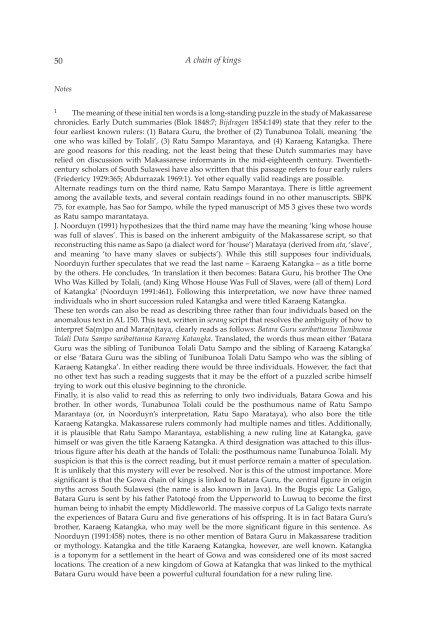A CHAIN OF KINGS - Books and Journals
A CHAIN OF KINGS - Books and Journals
A CHAIN OF KINGS - Books and Journals
Create successful ePaper yourself
Turn your PDF publications into a flip-book with our unique Google optimized e-Paper software.
50<br />
Notes<br />
A chain of kings<br />
1 The meaning of these initial ten words is a long-st<strong>and</strong>ing puzzle in the study of Makassarese<br />
chronicles. Early Dutch summaries (Blok 1848:7; Bijdragen 1854:149) state that they refer to the<br />
four earliest known rulers: (1) Batara Guru, the brother of (2) Tunabunoa Tolali, meaning ‘the<br />
one who was killed by Tolali’, (3) Ratu Sampo Marantaya, <strong>and</strong> (4) Karaeng Katangka. There<br />
are good reasons for this reading, not the least being that these Dutch summaries may have<br />
relied on discussion with Makassarese informants in the mid-eighteenth century. Twentiethcentury<br />
scholars of South Sulawesi have also written that this passage refers to four early rulers<br />
(Friedericy 1929:365; Abdurrazak 1969:1). Yet other equally valid readings are possible.<br />
Alternate readings turn on the third name, Ratu Sampo Marantaya. There is little agreement<br />
among the available texts, <strong>and</strong> several contain readings found in no other manuscripts. SBPK<br />
75, for example, has Sao for Sampo, while the typed manuscript of MS 3 gives these two words<br />
as Ratu sampo marantataya.<br />
J. Noorduyn (1991) hypothesizes that the third name may have the meaning ‘king whose house<br />
was full of slaves’. This is based on the inherent ambiguity of the Makassarese script, so that<br />
reconstructing this name as Sapo (a dialect word for ‘house’) Marataya (derived from ata, ‘slave’,<br />
<strong>and</strong> meaning ‘to have many slaves or subjects’). While this still supposes four individuals,<br />
Noorduyn further speculates that we read the last name ‒ Karaeng Katangka ‒ as a title borne<br />
by the others. He concludes, ‘In translation it then becomes: Batara Guru, his brother The One<br />
Who Was Killed by Tolali, (<strong>and</strong>) King Whose House Was Full of Slaves, were (all of them) Lord<br />
of Katangka’ (Noorduyn 1991:461). Following this interpretation, we now have three named<br />
individuals who in short succession ruled Katangka <strong>and</strong> were titled Karaeng Katangka.<br />
These ten words can also be read as describing three rather than four individuals based on the<br />
anomalous text in AL 150. This text, written in serang script that resolves the ambiguity of how to<br />
interpret Sa(m)po <strong>and</strong> Mara(n)taya, clearly reads as follows: Batara Guru saribattanna Tunibunoa<br />
Tolali Datu Sampo saribattanna Karaeng Katangka. Translated, the words thus mean either ‘Batara<br />
Guru was the sibling of Tunibunoa Tolali Datu Sampo <strong>and</strong> the sibling of Karaeng Katangka’<br />
or else ‘Batara Guru was the sibling of Tunibunoa Tolali Datu Sampo who was the sibling of<br />
Karaeng Katangka’. In either reading there would be three individuals. However, the fact that<br />
no other text has such a reading suggests that it may be the effort of a puzzled scribe himself<br />
trying to work out this elusive beginning to the chronicle.<br />
Finally, it is also valid to read this as referring to only two individuals, Batara Gowa <strong>and</strong> his<br />
brother. In other words, Tunabunoa Tolali could be the posthumous name of Ratu Sampo<br />
Marantaya (or, in Noorduyn’s interpretation, Ratu Sapo Marataya), who also bore the title<br />
Karaeng Katangka. Makassarese rulers commonly had multiple names <strong>and</strong> titles. Additionally,<br />
it is plausible that Ratu Sampo Marantaya, establishing a new ruling line at Katangka, gave<br />
himself or was given the title Karaeng Katangka. A third designation was attached to this illustrious<br />
figure after his death at the h<strong>and</strong>s of Tolali: the posthumous name Tunabunoa Tolali. My<br />
suspicion is that this is the correct reading, but it must perforce remain a matter of speculation.<br />
It is unlikely that this mystery will ever be resolved. Nor is this of the utmost importance. More<br />
significant is that the Gowa chain of kings is linked to Batara Guru, the central figure in origin<br />
myths across South Sulawesi (the name is also known in Java). In the Bugis epic La Galigo,<br />
Batara Guru is sent by his father Patotoqé from the Upperworld to Luwuq to become the first<br />
human being to inhabit the empty Middleworld. The massive corpus of La Galigo texts narrate<br />
the experiences of Batara Guru <strong>and</strong> five generations of his offspring. It is in fact Batara Guru’s<br />
brother, Karaeng Katangka, who may well be the more significant figure in this sentence. As<br />
Noorduyn (1991:458) notes, there is no other mention of Batara Guru in Makassarese tradition<br />
or mythology. Katangka <strong>and</strong> the title Karaeng Katangka, however, are well known. Katangka<br />
is a toponym for a settlement in the heart of Gowa <strong>and</strong> was considered one of its most sacred<br />
locations. The creation of a new kingdom of Gowa at Katangka that was linked to the mythical<br />
Batara Guru would have been a powerful cultural foundation for a new ruling line.









![Am HaSefer [Volk des Buches] - Books and Journals](https://img.yumpu.com/20648352/1/174x260/am-hasefer-volk-des-buches-books-and-journals.jpg?quality=85)







